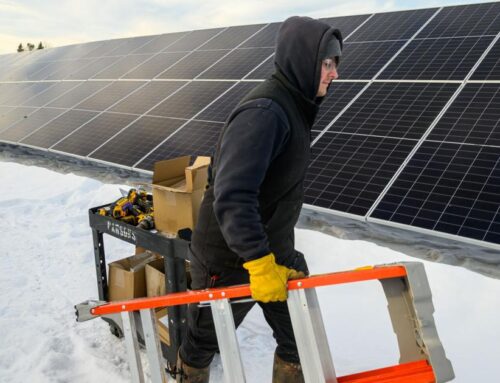Another 1,000 acres of state forest considered ‘suitable’ for solar by Michigan DNR
May 1, 2025
GAYLORD, MI – State officials reviewed at least five sites across northern Michigan for possible solar energy buildout in what’s become a controversial effort to increase renewable energy by deforesting state land.
Maps and other documents released to MLive under the state Freedom of Information Act show sites reviewed by officials include previously unknown areas in the Mackinaw and Pere Marquette state forests. Both those sites near Fife Lake and Mancelona were deemed ‘suitable’ to lease for solar panels in 2021, records show.
Officials said they have not reassessed those sites because of an ongoing pause on utility-scale solar on state land. It remains unknown whether any developers inquired about those locations.
Much of those state lands near Fife Lake and Mancelona appear largely forested, based on aerial photos and stand inventory descriptions released by the Michigan Department of Natural Resources.
The maps also include 1,600 acres near Muskrat Lake in Oscoda County. However, documents released to MLive show that site in prime Kirtland’s warbler habitat was deemed off limits.
The last two areas in maps released by the DNR were already known to the public: parcels near Gaylord and an area near Roscommon already under contract with a developer.
Related: Michigan plans to clear 400+ acres of state forest near Gaylord for solar farm
Released records show DNR officials reviewed 4,800 public acres across those five northern Michigan locations. All are either adjacent or in proximity to high-voltage transmission lines, considered a key factor for renewable energy development.
State officials said leasing 4,000 acres of public land statewide for solar energy is part of the DNR’s plan to increase revenues for the agency and accelerate Michigan toward its goal of 100% clean energy by 2040.
“If solar is going to be built out at the scale that this state is committed to, it has to go somewhere,” said Scott Whitcomb, director of DNR’s Office of Public Lands during a panel discussion April 23 at the state climate conference in Detroit.
When questioned by an audience member, Whitcomb argued some state forestlands may be appropriate for solar panels, such as those near major power lines.
Whitcomb declined to answer questions from an MLive reporter during the climate conference.
Still, critics contend deforesting public lands for solar energy undercuts climate efforts because of the lost carbon-consuming ability of the trees. Others lambaste the lost economic value of timber regrowth for the state’s $26 billion forests products industry.
Yet top DNR officials like Whitcomb and agency Director Scott Bowen argue the accelerating climate crisis is urgent enough that renewable energy must be quickly built everywhere possible – even on forested public lands – and more trees simply be conserved elsewhere.
Up north forests scoped for solar
Records released to MLive revealed at least two publicly unknown areas of state land officials deemed “suitable” for potential solar energy projects when reviewed four years ago.
That included 602 acres of the Mackinaw State Forest east of Mancelona and 426 acres of the Pere Marquette State Forest northeast of Fife Lake.
The larger site near Mancelona is alongside the same high-voltage transmission line that touches state land near Gaylord under consideration for solar energy leasing.
The maps show most of the 602 acres of public land were purchased when property owners fell behind on taxes, though two smaller parcels were bought with restricted state game funds. Inventory of tree stands show the acreage includes hardwoods, aspen and planted pines.
The 426-acre site by Fife Lake similarly includes aspen and planted pine. But the acreage is distinctive in its proximity to forested-shrub wetlands, according to released state maps.

Under FOIA, MLive sought copies of maps of every potential solar energy site for which DNR employees reviewed and contributed comments in the agency’s computerized system called its “Solar Recommendations Editor.”
Although the DNR says it already reviewed more than 30,000 acres for solar potential from among 4.6 million acres of public trust land it manages statewide, the agency released details of just 4,800 acres.
When asked how many more sites are highlighted in the system, DNR spokesperson Ed Golder said to seek that information through FOIA. He also said maps from their internal GIS system that show those additional locations are not actually public records.
“The solar recommendations editor is a tool that allows us to create temporary maps that are overlaid with various attributes. It’s only when we print or export those maps that they become a public record available through a Freedom of Information Act request,” Golder said by email.
Documents previously released to MLive in January showed state officials developed an internal GIS-based mapping system to identify “marginal lands” near high-voltage power lines. Parks, fisheries, forestry and wildlife employees reviewed the targeted lands, but their feedback was redacted and blackened out in released records.

News in January of the possible conversion of 420 acres of forestland to solar panels on state property near Gaylord prompted public outrage. Subsequently, the DNR paused all land leases for solar energy not already on the books.
Related: Michigan DNR pauses future land leases for solar arrays after ‘outcry’ over Gaylord site
Only two state land leases for solar energy are already inked with developers. Contract documents released April 21 confirm projects near Roscommon and in Dickinson County in the Upper Peninsula. Both those sites include brownfields, including a gravel pit and small airport near Roscommon and an open-pit iron mine in the western U.P.
Foresters, conservationists and climate advocates
There is a bounty of opinions about whether state forests should be converted to solar farms.
Some argue the greenhouse gas-guzzling ability of forests makes them a powerful natural climate solution. That society shouldn’t take trees for granted in the climate fight, especially those growing on public trust lands.
Others contend that because global atmospheric concentrations of carbon continue to surge, the race is on to build enough emissions-free energy sources to meet demands and still retire fossil fuel power plants.
Top DNR officials say they want to be part of the renewable energy buildout to help fight climate change. The state can always buy more forestland with solar lease revenues and natural resources trust fund dollars earned from oil and gas royalties, officials said.
That acre-for-acre state forest replacement was touted by state officials and supporters in the climate advocacy community who say they want the DNR to get back to finding places where it may be best to build solar arrays.
Groundwork Center for Resilient Communities recently asked its supporters to encourage the state to ends its pause on leasing public lands for solar because of the crucial need for more homegrown clean energy.
Ashley Rudzinski, the organization’s climate director, said to meet the state’s goal of 60% renewable energy by 2030 and carbon neutrality by 2050, it will require significant buildout of solar across Michigan.
“And there simply isn’t enough low-conflict private land to be able to get us there on time,” Rudzinski said. That’s why the DNR is targeting what they call “marginal lands,” she said.
State lands like brownfields or places already clear cut should be targeted instead of high-value natural areas or recreational places where people hike, hunt and fish, Rudzinski said.
Related: Solar deforestation plans faced internal backlash at Michigan DNR, documents show
However, opinions about what should be considered marginal lands also vary.
On April 11, foresters toured several state-owned parcels near Gaylord the DNR is considering leasing for solar. The Michigan Society of American Foresters hosted the field tour.
Tour guide Dave Kossak, the group’s policy chairperson, said at a clear-cut and replanted site that he took umbrage when the dedicated red pine plantation was called “marginal lands.” It was the result of the state’s own forestry plans, he said.
Kossak argued the site provided valuable timber when it was harvested in recent years and would do so again in four or five decades. In fact, he said red pine is statistically the most productive species in terms of growing wood fiber in Michigan.
The forestry society intends to offer input to the DNR on leasing state forestland for solar power and the question is whether the group opposes deforestation for solar or if it’s a matter of “net deforestation,” Kossak said.
Replacing state forests converted to solar farms by buying forestland from others merely changes who holds the deed. It’s not regrowing trees, he said.
“If they were purchasing agricultural land and planting trees that would be no net loss,” he said. “You’re just saying you didn’t lose any land. Michigan did. Michigan is still losing forestland.”
Related: Worries arise over whether Michigan DNR will have public hearing on solar plan
For others, transparency of this process doesn’t measure up.
Justin Tomei, policy and government affairs manager for hunting and fishing-focused Michigan United Conservation Clubs, said the group doesn’t reject all possible solar sites but argues only those ill-suited for other purposes should be targeted.
“They need to tell us all the lands that they considered. They need to give us the scorecards. They need to give us one-to-one land transactions. They need to give us the definition of marginal lands,” Tomei said.
Sign up to receive Lake Effect, MLive’s weekly climate and environment newsletter.
Search
RECENT PRESS RELEASES
Related Post



